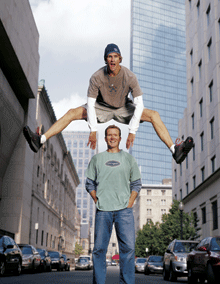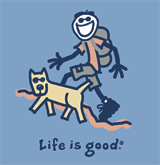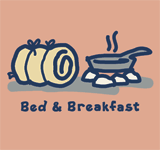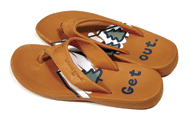 |

|
Q&A: LIfe is Good's Bert Jacobs
MARCH 01, 2006 --
 In 1989, two brothers, Bert and John Jacobs, started hawking T-shirts on the streets of Boston, eventually quitting their substitute teaching jobs to take a five-year jaunt through college towns lining the eastern seaboard. Sleeping on T-shirts in the back of a van, the two pounded on dormitory doors until their supply was sold out, only to restock and hit the road again. In 1994, they sold the first Life is Good T-shirt at a street fair in Boston featuring Jake, the company's happy-go-lucky beatnik icon; and slowly, Jake has become a phenomenon. In 1989, two brothers, Bert and John Jacobs, started hawking T-shirts on the streets of Boston, eventually quitting their substitute teaching jobs to take a five-year jaunt through college towns lining the eastern seaboard. Sleeping on T-shirts in the back of a van, the two pounded on dormitory doors until their supply was sold out, only to restock and hit the road again. In 1994, they sold the first Life is Good T-shirt at a street fair in Boston featuring Jake, the company's happy-go-lucky beatnik icon; and slowly, Jake has become a phenomenon.
In 2005, sales for the Derry, NH-based company reached approximately $59 million, well above the target of $48 million, and dwarfing 2004's level of $35 million. But Bert Jacobs, the company's president, says Life is Good is not aiming to blow out the brand.
“We're much more focused on making higher-quality products, having better merchandising at retail, and servicing better,” he says. “The idea is not to necessarily get bigger. That's happening and we shouldn't fight that. But rather than working and planning to get bigger, we're planning to get stronger.”
OB talked to Bert Jacobs about the widespread appeal of Life is Good, the brand's growth potential, as well as the company's deep commitment to doing good.
Why do you think Life is Good has been so successful?
JACOBS: So many retailers and customers of ours have asked us how long we think this is going to last because they see these lifestyle things come and go. But I think the difference is that the foundation of those brands that come and go are usually tied to a trend, either a fashion or cultural trend. And when that trend tails off, so does the brand. The foundation of our brand is optimism, and optimism is timeless. It always has a place in every demographic and in every economy, and it's always something that's in need. Certainly, you can make the claim that the media is overly focused on what's wrong with the world. As a result, consumers get inundated with negative information. So ours is something that butts up against that. It's refreshingly different to what people are hearing all the time, and people are attracted to that. The other element that I think has been important to our longevity is that we're also living in a world that is technologically advancing so fast and everything's become so very complex. Its like we're racing into this 21st century. So what our brand does well is it causes [people to] pause, and causes people to take note and celebrate things that are so simple, and in some ways old-fashioned, that they could have existed 100 years ago. So that's also a uniqueness. We don't always have to be pushing the latest and greatest.
 I guess it also helps that you work in many categories? I guess it also helps that you work in many categories?
JACOBS: Outdoor may be our biggest channel, but we're also competing in sporting goods, surf and skate, resort, running specialty, spa and wellness, golf, and on and on. The message is applicable to any of those. We like to say Jake is an athlete, an optimist and a cultural hero. So with the athlete part, he can do anything and everything as long as it's tied to a positive lifestyle. I also think that something that's central to the outdoor market, as well as sporting goods and resort, is family and family business. And while we can't really pinpoint a demographic for us, if we had to sort of group a demographic, the family unit would be the most important. And there are not that many messages that a whole family embraces.
How is the T-shirt business doing?
JACOBS: T-shirts are still the heart and soul and core of our business. Jake and Jake's dog, Rocket, have really grown to have tremendous appeal in the market and people like to have fun making up stories about what Jake and his dog do. It's real important to have those icons that the family can embrace. But T-shirts have dramatically decreased as a percentage of our business. They were the accessible vehicle for our brand and now we're finding a lot of success outside of it.
Do you ever worry about running out of new graphics for the shirts?
JACOBS: You never run out. Every year we have sketchbooks upon sketchbooks and piles of things that don't make it into the line. The harder thing is making the cuts.
 OB: Where else are you finding success in apparel? OB: Where else are you finding success in apparel?
JACOBS: The first place we started having success was with headwear. We have knits in the fall and winter, and we do a tremendous baseball cap and bucket hat business pretty much year round. Shorts have been tremendous. We've done some performance shorts called the Life is Good River shorts, but we've also done cabin shorts for hiking and basically hanging out. In bottoms, we introduced lounge pants, and we probably did about quadruple the volume we expected to do in our initial year. Boxers have also been a huge business; and socks, which we launched last year, have grown very rapidly. Then we have specific segments. We have the Harmony Collection that's targeted at yoga and wellness, and that's been very successful. And the golf market is one of our fastest-growing targets.
OB: Do you use any performance fabrics?
JACOBS: We're [mostly] a cotton brand. In many cases, when you have a retailer, particularly in outdoor, that carries all performance-related stuff, we tend to be the one brand that's non-performance in their stores. But we listen very closely to our retailers and over the last few years they were calling for us to get into some technical fabric. We tested it out and it was very well accepted. When you look at technical shirts for running, for example, the options out there are very simple, understated logos in the left chest, and the color palettes are black and white and gray-if you're lucky. So we introduced a color palette that mimicked what we've been doing in garment-dyed T-shirts for years and added full-on graphics with it, and I think those have been great points of difference.
OB: What other categories are you excited about besides apparel?
JACOBS: We're just introducing jewelry and that is really taking off. It's mostly natural elements-leather, bone, natural stones and some weathered steel. So it's a bit earthy/crunchy and very simplistic, much like our graphics. Most of what we design tends to look like a child could design it, and that's true for the jewelry, as well. Another very promising category we're launching in January for the Spring market is sandals. It will be our entry into footwear and we're very excited about that. It's booking very well. It took us awhile to break out of the stigma of being a T-shirt brand and I think now that we've done that, our retailers have been terrific about trying new things.
 OB: How do you explain your success in coffee mugs, Frisbees and pet products? OB: How do you explain your success in coffee mugs, Frisbees and pet products?
JACOBS: People have said to us, 'Don't you guys need to stay more focused? You're getting your hands into too many things.' But I think we are a rare brand that can keep people on their toes and guessing what we're going to do next. As long as we're dedicated to making really good products and only launching in categories when we're really ready, then I think we're safe. There are not too many brands that could do it, but I think ours is one that can.
OB: Who do you sell to?
JACOBS: It's mostly Mom & Pop specialty stuff. We have few bigger great customers like REI and Dick's Sporting Goods, and we have a handful of regional guys that do a terrific job, too. But really our bread and butter is the Mom & Pop retailer with one or two stores. It's a little more service-oriented than selling only big guys, but it's the only way we know. We're used to it at this point.
OB: What is the strategy behind the roll out of Genuine Neighborhood Shoppes?
JACOBS: It's a pretty unique concept. We have a handful of small guys that started over time taking more and more things out of their store and ended up with only Life is Good stuff. And that was a bit of an experiment that proved very effective. That dedicated space didn't grow sales by 10, 20 or 30 percent; it doubled, and in a few cases, tripled the business they were doing. At the same time, we decided that we didn't want to roll out hundreds of company-owned stores. We didn't want to look like Starbucks or The Gap with a Life is Good store on every corner. So the idea with the Genuine Neighborhood Shoppes is we can remain true to our current model of using independent retailers, get the dedicated space that showcases the entire brand, and we can let them name the store. It could be 'Tom's Outfitter' and we'll hang a sign that says “A Genuine Life is Good Neighborhood Shoppe.” We have 26 of them currently in the country and we have 64 applications in.
OB: What about your shop-in-shop programs at places like Dick's?
JACOBS: Store-within-a-store is a very big initiative. We take them one at a time depending on the level of commitment from the retailer. Dick's has just been a fantastic partner. Sometimes a bigger retailer will tell you, 'We're going to do this and treat the brand how you like,' but talk is cheap. With Dick's, they've really backed it up. They, and REI too, are both examples to us of big guys that act like small guys and that's very attractive to us. We're also trying to encourage all of our Mom & Pop retailers to dedicate even a small area to Life is Good. We tend to see a much higher rate of multiple purchases when that happens versus departmentalizing.
 OB: You have some whacky charitable campaigns. Can you discuss these? OB: You have some whacky charitable campaigns. Can you discuss these?
JACOBS: What we do is run outdoor festivals that are free to the public and we usually have some crazy theme, like the Pumpkin Festival in Boston where we try to break the Guinness [World] Record for the most lit pumpkins. Or the Watermelon Festival where strong men are throwing watermelons. So there will always be a lot of fun to it. But in the end, the focus is on raising awareness and money for families of kids with life-threatening illnesses. There's a camp in Maine called Camp Sunshine that's a beneficiary of ours, and it's the only one of its kind that focuses on the entire family. To us, that's a more important [way to spend] money than by just creating a bunch of advertising and fluff that tries to push the brand. This may not come back to the brand right away. But if it never does, you never regret the money that you spent. And eventually, we think it will come back to the brand in a way that's more sincere. So, as our business grows, we're going to end up dedicating more financial and human resources to these efforts internally. We believe this is the most important thing that we're doing.
OB: Where do you see Life is Good in five years?
JACOBS: I think that one day we'll be a billion-dollar brand. I don't say that because the number is important to reach, but to put into perspective the potential that we think this brand has to continue to grow. So five years from now, maybe we're about a third of the way there. What we want to look like is a leader in modeling a capitalistic business that is able to successfully tie its profits to very meaningful causes. That's really central to why we're in business and what we're all about, and it feeds very well into the message that we bring to retail.
OB: Do you look to any other companies, such as Ben & Jerry's, as role models?
JACOBS: Certainly [they] were a leader in being socially responsible. I think Patagonia has done wonderful things. But in an odd way, we take more of our inspiration from someone that comes from totally outside of our industry and that's Dr. Seuss. Ted Geisel was his real name. Like many kids, my brother and I were infatuated with the Dr. Seuss books. As adults looking back, we look at him as a hero for creating these simplistic, childlike characters that always told a story and always had great meaning and social value. He taught kids to read, but also taught wonderful messages about the environment, or treating others well, or about the real meaning of Christmas not coming from a store in “The Grinch That Stole Christmas.” It was brilliant. You have so much fun with them that you don't realize you're learning. So we take a lot of inspiration from him and we like to feel that in our own way, we're having a positive impact on culture by bringing optimism to people and having a lot of fun along the way.
OB: But can you rhyme like Dr. Seuss?
JACOBS: Not as well. But we're working on it.
|
|
|
 |
|
 |
|


 In 1989, two brothers, Bert and John Jacobs, started hawking T-shirts on the streets of Boston, eventually quitting their substitute teaching jobs to take a five-year jaunt through college towns lining the eastern seaboard. Sleeping on T-shirts in the back of a van, the two pounded on dormitory doors until their supply was sold out, only to restock and hit the road again. In 1994, they sold the first Life is Good T-shirt at a street fair in Boston featuring Jake, the company's happy-go-lucky beatnik icon; and slowly, Jake has become a phenomenon.
In 1989, two brothers, Bert and John Jacobs, started hawking T-shirts on the streets of Boston, eventually quitting their substitute teaching jobs to take a five-year jaunt through college towns lining the eastern seaboard. Sleeping on T-shirts in the back of a van, the two pounded on dormitory doors until their supply was sold out, only to restock and hit the road again. In 1994, they sold the first Life is Good T-shirt at a street fair in Boston featuring Jake, the company's happy-go-lucky beatnik icon; and slowly, Jake has become a phenomenon.  I guess it also helps that you work in many categories?
I guess it also helps that you work in many categories?
 OB: Where else are you finding success in apparel?
OB: Where else are you finding success in apparel?
 OB: How do you explain your success in coffee mugs, Frisbees and pet products?
OB: How do you explain your success in coffee mugs, Frisbees and pet products?
 OB: You have some whacky charitable campaigns. Can you discuss these?
OB: You have some whacky charitable campaigns. Can you discuss these?
